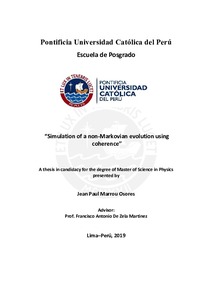| dc.contributor.advisor | Zela Martínez, Francisco Antonio de | |
| dc.contributor.author | Marrou Osores, Jean Paul | es_ES |
| dc.date.accessioned | 2019-06-13T02:56:15Z | es_ES |
| dc.date.available | 2019-06-13T02:56:15Z | es_ES |
| dc.date.created | 2019 | es_ES |
| dc.date.issued | 2019-06-12 | es_ES |
| dc.identifier.uri | http://hdl.handle.net/20.500.12404/14386 | |
| dc.description.abstract | This thesis will be oriented in the study of open quantum systems. The transition of processes
that go between the Markovian and non-Markovian regime will be studied. The diagnose of
non-Markovianity will be made in terms of the variation of the coherence of the state.
Accordingly, an optical setup will be implemented that allows us to manipulate certain
degrees of freedom, like the polarization and the optical path. Theoretically, we have found
that the coherence of the system is transferred to the environment and it decreases as we
move a parameter that we will take as time. This situation has been confirmed in the
experiment. Then, due to the second part of the setup, which produces a non-Markovian
evolution by also changing one of its parameters, we have accomplished the goal of returning
the information back into the system and to measure the non-Markovianity of the process. | es_ES |
| dc.description.abstract | El trabajo de tesis estará orientado al estudio de sistemas cuánticos abiertos. Se estudiará la
transición de procesos que van del régimen Markoviano al no Markoviano en forma
controlada. El diagnóstico de no Markovianidad se hará en términos de la variación de la
coherencia del estado. Para ello se implementará un arreglo óptico que permita manipular
varios grados de libertad, tales como polarización y camino óptico. Teóricamente,
encontramos que la coherencia del sistema se transfiere al entorno y disminuye al mover uno
de estos parámetros que tomaremos como el tiempo, lo que se ha podido comprobar en el
experimento. Posteriormente, utilizando otro arreglo que produce una evolución no-
Markoviana cambiando uno de sus parámetros también como el tiempo, se ha logrado
recuperar la coherencia del sistema. De esta manera se hace posible el retorno de la
información y la medición de la no-Markovianidad de dicho proceso. | es_ES |
| dc.language.iso | eng | es_ES |
| dc.publisher | Pontificia Universidad Católica del Perú | es_ES |
| dc.rights | Atribución-NoComercial 2.5 Perú | * |
| dc.rights | info:eu-repo/semantics/openAccess | es_ES |
| dc.rights.uri | http://creativecommons.org/licenses/by-nc/2.5/pe/ | * |
| dc.subject | Sistemas cuánticos | es_ES |
| dc.subject | Procesos de Markov | es_ES |
| dc.subject | Coherencia (Física) | es_ES |
| dc.title | Simulation of a non-Markovian evolution using coherence | es_ES |
| dc.type | info:eu-repo/semantics/masterThesis | es_ES |
| thesis.degree.name | Magíster en Física | es_ES |
| thesis.degree.level | Maestría | es_ES |
| thesis.degree.grantor | Pontificia Universidad Católica del Perú. Escuela de Posgrado | es_ES |
| thesis.degree.discipline | Física | es_ES |
| renati.advisor.dni | 10540939 | |
| renati.discipline | 533017 | es_ES |
| renati.level | https://purl.org/pe-repo/renati/level#maestro | es_ES |
| renati.type | http://purl.org/pe-repo/renati/type#tesis | es_ES |
| dc.publisher.country | PE | es_ES |
| dc.subject.ocde | https://purl.org/pe-repo/ocde/ford#1.03.00 | es_ES |






